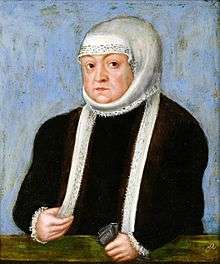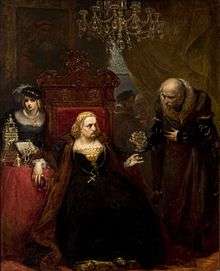Bona Sforza
| Bona Sforza | |
|---|---|
 Queen Mother Bona by Lucas Cranach the Younger | |
| Queen consort of Poland Grand Duchess consort of Lithuania | |
| Tenure | 1518–1548 |
| Coronation | 18 April 1518 |
| Born |
2 February 1494 Vigevano, Italy |
| Died |
19 November 1557 (aged 63) Bari, Italy |
| Burial | Basilica di San Nicola, Bari |
| Spouse | Sigismund I of Poland |
| Issue more... |
Isabella, Queen of Hungary Sigismund II Augustus of Poland Sophia, Duchess of Brunswick-Lüneburg Anna I of Poland Catherine, Queen of Sweden |
| House | Sforza |
| Father | Gian Galeazzo Sforza |
| Mother | Isabella of Naples |
Bona Sforza (2 February 1494 – 19 November 1557) was a member of the powerful House of Sforza, which ruled the Duchy of Milan since 1447. In 1518, she became the second wife of Sigismund I the Old, the King of Poland and Grand Duke of Lithuania. Their marriage lasted 30 years until Sigismund's death in 1548. Ambitious and energetic, Bona became heavily involved in the political life of Poland–Lithuania. To increase state revenue, she implemented various economic and agricultural reforms, including the far-reaching Wallach Reform in the Grand Duchy of Lithuania. Her reforms made her the richest landowner in the Grand Duchy. In foreign policy, she opposed the Habsburgs and sought to secure her eldest daughter Isabella Jagiellon in the Kingdom of Hungary.
Early years
Childhood in Milan and Bari
Bona was the third of the four children of Gian Galeazzo Sforza and his wife Isabella of Naples. Gian Galeazzo was the legal heir to the Duchy of Milan, but his uncle and regent Ludovico Sforza, known to history as "Il Moro", usurped the power. The couple was sent to live at the Castello Visconteo in Pavia, where Gian Galeazzo died in 1494. Rumors spread that he was poisoned by Ludovico. The family moved to the Sforza Castle in Milan, where they lived under the watchful eye of Ludovico. He was afraid that Milan residents would rebel and install Francesco Sforza, the popular son of Gian Galeazzo. To minimize the risk, Ludovico separated the boy from his family and granted Bari and Rossano to Isabella. The plans were interrupted by the Italian War of 1499–1504. King Louis XII of France deposed Ludovico (see Treason of Novara) and took Francesco with him to Paris.
Isabella had nothing left in Milan and departed for her native Naples in February 1500. The war reached the Kingdom of Naples and Isabella's uncle Frederick of Naples was deposed. Together with other relatives, she temporarily hid at the Aragonese Castle on Ischia. In April 1502, Isabella and her sole surviving daughter Bona settled at the Castello Normanno-Svevo in Bari more permanently. There Bona started her extensive education. Her teachers included Italian humanists Crisostomo Colonna and Antonio de Ferraris who taught her Latin, classical literature, mathematics, history, law, natural science, theology, even geography. Bona could also play several musical instruments.
Marriage proposals

When the House of Sforza was restored to the Duchy of Milan in 1512, Isabella hoped to wed Bona and Duke Maximilian Sforza thereby providing further legitimacy to Maximilian's reign. There were other proposals as well: Spanish King Ferdinand II of Aragon proposed Giuliano de' Medici, brother of Pope Leo X; Isabella counter-proposed Ferdinand's ten-year-old grandson Ferdinand of Habsburg who was expected to inherit the Spanish throne; Pope Leo X proposed Philippe who would succeed to the Duchy of Savoy if his brother Charles III abdicated. The initial and most likely plan to marry Maximilian Sforza failed when he was deposed after the French victory in the Battle of Marignano in 1515. Pope Leo X proposed his nephew Lorenzo de' Medici as he hoped, using Bona's inheritance claims to the Milan, to install Lorenzo as Duke of Milan. However, the French hold on Milan was too strong and the plan failed.

Polish King Sigismund I the Old was widowed in October 1515. Maximilian I, Holy Roman Emperor, did not want Sigismund to marry another Habsburg opponent like his late wife Barbara Zápolya. Therefore, the emperor acted quickly and selected three suitable candidates for Sigismund: his granddaughter Eleanor of Austria, widowed Queen Joanna of Castile, and Bona Sforza. Thirty-six-year-old Joanna was eliminated because of her age. The hand of Eleanor was refused by her brother who instead selected Manuel I of Portugal for her husband. Polish nobles suggested Anna Radziwiłł, widow of Konrad III of Masovia. Isabella sent Bona's old teacher Crisostomo Colonna and diplomat Sigismund von Herberstein to Vilnius to convince Sigismund to select Bona. They succeeded and the marriage treaty was signed in September 1517 in Vienna. Jan Konarski, Archbishop of Kraków, traveled to Bari to bring Bona to Poland.
The wedding per procura took place on 6 December 1517 in Naples. Bona wore a dress of light blue Venetian satin that reportedly cost 7,000 ducats. The journey to Poland took more than three months. Bona and Sigismund met for the first time on 15 April 1518 just outside Kraków. The wedding and coronation took place on 18 April, but celebrations continued for a week. Bona's dowry was very large – 100,000 ducats and personal items worth 50,000 ducats in addition to Bari and Rossano that she would inherit after her mother's death. In exchange for the dowry, Sigismund granted her the towns of Nowy Korczyn, Wiślica, Żarnów, Radomsko, Jedlnia, Kozienice, Chęciny, Inowrocław, and others.
Queen of Poland
Family life

Bona was energetic, even hot-tempered, while Sigismund was much calmer and passive. From the beginning, Bona became involved in various state affairs, which did not agree with the traditional ideal of a royal wife – obedient, devoted to husband and children. Bona and Sigismund disagreed on many domestic and foreign issues and were known to have arguments, but the marriage did not collapse. Bona did not travel with her husband – from the first four and a half years of marriage, she spent three years alone in the Wawel castle. Despite that, in the first nine years Bona was pregnant seven times. Frequent pregnancies prevented her from becoming fully engaged in the political life.
In September 1527, as a result of a fall from a horse, the Queen gave birth prematurely to her second son Albert, who died at birth.[1] Due to the injuries, Bona could not have any more children. Bona, wanting to ensure the continuity of the Jagiellonian dynasty on the Polish throne, decided to make the nobles and magnates to recognise her only son, the minor Sigismund Augustus as heir to the throne. First, the Lithuanian nobles gave him the ducal throne (ca. 1527-1528). Then, in 1529 he was crowned Sigismund II Augustus. This led to huge opposition from Polish lords, which led to the adoption of the bill that the next coronation would take place after the death of Sigismund Augustus, and that it would do so with the consent of all the noble brothers.
In 1544, Sigismund II Augustus was given independent authority in Lithuania, and he moved there. It was the cause of a significant weakening of power in the queen, who did not want his departure. The pair had originally entered into a conflict over her son's marriage to Barbara Radziwiłł.
Domestic policy

Almost from the beginning of her life in Poland, Queen Bona tried to gain a strong political position and began forming a circle of supporters. On 23 January 1519, Pope Leo X, whom she had friendly relationship with from her Italian days, granted her a privilege allowing her to award eight benefices in five Polish cathedrals (Kraków, Gniezno, Poznań, Włocławek and Frombork). In May 1519, the privilege was expanded to fifteen benefices. This was a very important privilege that allowed Bona to secure support of various officials. Three of her most trusted supporters, Piotr Kmita Sobieński, Andrzej Krzycki and Piotr Gamrat, were sometimes known as Triumvirate.
Bona came out of the belief that one of the most important things needed for the effective implementation of policies and plans for strengthening royal authority is access to appropriate high finance. Therefore, she set herself the objective of magnification and the assembly domain of dynastic wealth as much as possible, which would give the Jagiello family financial independence. The family gained numerous estates in Lithuania, and finally in 1536-1546 they took over the Grand Duchy of Lithuania. This generated huge profits. Bona managed to also carry out tax reforms in Lithuania and agricultural products (including uniform duties of the peasants and a unit of area measurements).
In 1539 Bona Sforza had presided, reluctantly, over the burning of 80-year-old Katarzyna Weiglowa for heresy, but this event ushered in an era of tolerance, and her confessor Francesco Lismanino assisted in the establishment of a Calvinist Academy in Pińczów.
Foreign policy
In foreign policy, she was a fierce opponent of the Habsburgs and a supporter of a closer alliance with the Kingdom of France. In Hungary during the wars that took place after the Battle of Mohacs in 1526, supported by John Zápolya against the Habsburgs. Bona also sought to maintain good relations with Sublime Porte and contacts with Roxelana, the most important wife of Suleyman the Magnificent. Bona was also a spokesperson for connecting Silesia to the Crown in return for her hereditary principality Bari and Rosano, but Sigismund the Old did not support the idea and the whole project collapsed.
Widowhood

On the 1 April 1548, Sigismund I the Old died, leaving Bona a widow. Their son succeeded him.
After the death of the King, Bona moved to Masovia and stayed there for eight years before moving back to her native Bari.
A year after returning to the Duchy of Bari, Bona Sforza was poisoned by her trusted officer, Gian Lorenzo Pappacoda. Pappacoda was acting on behalf of King Philip II of Spain, who wished to avoid repaying his sizable debts to the Polish queen. She was buried in St. Nicholas' Basilica in Bari, where her daughter Anna had a tomb made in the current Renaissance style for her remains.
Children
Bona and Sigismund I the Old had six children:
- Isabella (18 January 1519 – 15 September 1559), was a Queen of Hungary, wife of John Zápolya;
- Sigismund II Augustus (1 August 1520 – 7 July 1572), was a King of Poland and Grand Duke of Lithuania;
- Sophia (13 July 1522 – 28 May 1575), was a Duchess of Brunswick-Lüneburg, wife of Henry V, Duke of Brunswick-Lüneburg;
- Anna (18 October 1523 – 9 September 1596), was a King of Poland and Grand Duke of Lithuania, wife of Stefan Batory;
- Catherine (1 November 1526 – 16 September 1583), was a Queen of Sweden and Grand Duchess of Finland, wife of John III of Sweden;
- Wojciech Olbracht, born and died 20 September 1527.
Ancestors
| Ancestors of Bona Sforza | ||||||||||||||||||||||||||||||||||||||||||||||||||||||||||||||||||||||||||||||||||||||||||||||||||||||||||||||||||||||||||||||||||||||||||||||||||||||||||||||||||||||||||||||||||||||||||||||||||||||||||||||||||||||||||||||||||||||||||||||||||||||||||||||||||||||||||||||||||||||||||||||||||||||||||||||||||||||||||||||||||||||||||||||||||||||||||||||||||||||||||||||||||||||||||||||||||||||||||||||||||||||||||||||||||||||||||||||||||||||||||||||||||||||||||||||||||||||||||||||||||||||||||||||||||||||||||||||||||
|---|---|---|---|---|---|---|---|---|---|---|---|---|---|---|---|---|---|---|---|---|---|---|---|---|---|---|---|---|---|---|---|---|---|---|---|---|---|---|---|---|---|---|---|---|---|---|---|---|---|---|---|---|---|---|---|---|---|---|---|---|---|---|---|---|---|---|---|---|---|---|---|---|---|---|---|---|---|---|---|---|---|---|---|---|---|---|---|---|---|---|---|---|---|---|---|---|---|---|---|---|---|---|---|---|---|---|---|---|---|---|---|---|---|---|---|---|---|---|---|---|---|---|---|---|---|---|---|---|---|---|---|---|---|---|---|---|---|---|---|---|---|---|---|---|---|---|---|---|---|---|---|---|---|---|---|---|---|---|---|---|---|---|---|---|---|---|---|---|---|---|---|---|---|---|---|---|---|---|---|---|---|---|---|---|---|---|---|---|---|---|---|---|---|---|---|---|---|---|---|---|---|---|---|---|---|---|---|---|---|---|---|---|---|---|---|---|---|---|---|---|---|---|---|---|---|---|---|---|---|---|---|---|---|---|---|---|---|---|---|---|---|---|---|---|---|---|---|---|---|---|---|---|---|---|---|---|---|---|---|---|---|---|---|---|---|---|---|---|---|---|---|---|---|---|---|---|---|---|---|---|---|---|---|---|---|---|---|---|---|---|---|---|---|---|---|---|---|---|---|---|---|---|---|---|---|---|---|---|---|---|---|---|---|---|---|---|---|---|---|---|---|---|---|---|---|---|---|---|---|---|---|---|---|---|---|---|---|---|---|---|---|---|---|---|---|---|---|---|---|---|---|---|---|---|---|---|---|---|---|---|---|---|---|---|---|---|---|---|---|---|---|---|---|---|---|---|---|---|---|---|---|---|---|---|---|---|---|---|---|---|---|---|---|---|---|---|---|---|---|---|---|---|---|---|---|---|---|---|---|---|---|---|---|---|---|---|---|---|---|---|---|---|---|---|---|---|---|---|---|---|---|---|---|---|---|---|---|---|---|---|---|---|---|---|---|---|---|---|---|---|---|---|---|---|---|---|---|---|---|---|---|---|---|---|---|---|---|---|---|---|---|---|---|---|---|---|---|---|---|---|---|---|---|---|---|---|---|---|---|---|---|---|---|---|---|---|---|---|---|---|---|---|---|---|---|---|---|---|---|---|---|---|---|---|
| ||||||||||||||||||||||||||||||||||||||||||||||||||||||||||||||||||||||||||||||||||||||||||||||||||||||||||||||||||||||||||||||||||||||||||||||||||||||||||||||||||||||||||||||||||||||||||||||||||||||||||||||||||||||||||||||||||||||||||||||||||||||||||||||||||||||||||||||||||||||||||||||||||||||||||||||||||||||||||||||||||||||||||||||||||||||||||||||||||||||||||||||||||||||||||||||||||||||||||||||||||||||||||||||||||||||||||||||||||||||||||||||||||||||||||||||||||||||||||||||||||||||||||||||||||||||||||||||||||
See also
| Wikimedia Commons has media related to Bona Sforza. |
- List of Polish rulers
- Polish cuisine
- Chicken War - the article contains an image of a triumphant Bona
References
- ↑ Grzybowski, Polish history and Lithuania (1506-1648), P. 47
| Bona Sforza Born: 2 February 1494 Died: 19 November 1557 | ||
| Royal titles | ||
|---|---|---|
| Preceded by Barbara Zápolya |
Queen consort of Poland Grand Duchess consort of Lithuania 1518–1548 with Elisabeth of Austria (1543-1545) |
Succeeded by Barbara Radziwiłł |
| Italian nobility | ||
| Preceded by Isabella of Aragon |
Duchess of Bari Princess of Rossano 1524–1557 |
Annexed by Naples |
| Titles in pretence | ||
| Preceded by Isabella of Aragon |
Brienne claim 1524–1557 |
Succeeded by Sigismund II Augustus |